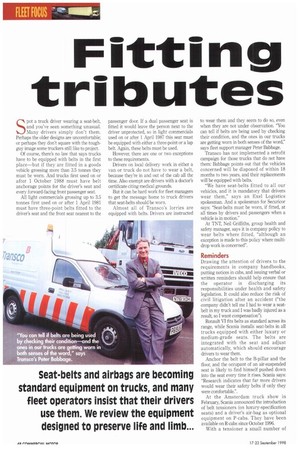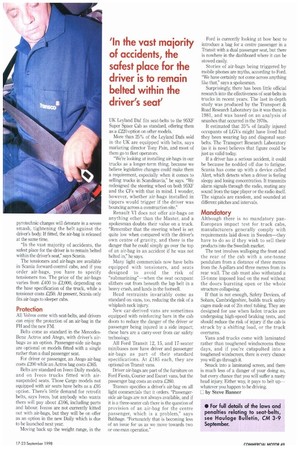Fitting tributes
Page 60

Page 61

If you've noticed an error in this article please click here to report it so we can fix it.
Spot a truck driver wearing a seat-belt, and you've seen something unusual. Many drivers simply don't them. Perhaps the older designs are uncomfortable; or perhaps they don't square with the toughguy image some truckers still like to project.
Of course, there's no law that says trucks have to be equipped with belts in the first place—but if they are fitted in a goods vehicle grossing more than 3.5 tonnes they must be worn. And trucks first used on or after 1 October 1988 must have belt anchorage points for the driver's seat and every forward-facing front passenger seat.
All light commercials grossing up to 3.5 tonnes first used on or after 1 April 1981 must have three-point belts fitted to the driver's seat and the front seat nearest to the passenger door. If a dual passenger seat is fitted it would leave the person next to the driver unprotected, so in light commercials used on or after 1 April 1987 this seat must be equipped with either a three-point or a lap belt. Again, these belts must be used.
However, there are one or two exceptions to these requirements.
Drivers on local delivery work in either a van or truck do not have to wear a belt, because they're in and out of the cab all the time. Also exempt are drivers with a doctor's certificate citing medical grounds.
But it can be hard work for fleet managers to get the message home to truck drivers that seat-belts should be worn.
Almost all of Transco's lorries are equipped with belts. Drivers are instructed to wear them and they seem to do so, even when they are not under observation. "You can tell if belts are being used by checking their condition, and the ones in our trucks are getting worn in both senses of the word," says fleet support manager Peter Babbage.
Transco has not implemented a retrofit campaign for those trucks that do not have them: Babbage points out that the vehicles concerned will be disposed of within 18 months to two years, and their replacements will be equipped with belts.
"We have seat-belts fitted to all our vehicles, and it is mandatory that drivers wear them," says an Exel Logistics spokesman. And a spokesman for Securicor says: "Seat-belts must be worn, if fitted, at all times by drivers and passengers when a vehicle is in motion."
At TNT, Neil Griffiths, group health and safety manager, says it is company policy to wear belts where fitted, "although an exception is made to this policy where multi. drop work is concerned".
Reminders
Drawing the attention of drivers to the requirements in company handbooks, putting notices in cabs, and issuing verbal or written reminders should help ensure that the operator is discharging its responsibilities under health and safety legislation. It could also reduce the risk of civil litigation after an accident ("the company didn't tell me I had to wear a seatbelt in my truck and I was badly injured as a Asult, so I want compensation").
Renault VI fits belts as standard across its range, while Scania installs seat-belts in all trucks equipped with either luxury or medium-grade seats. The belts are integrated with the seat and adjust automatically, which should encourage drivers to wear them.
Anchor the belt to the B-pillar and the floor, and the occupant of an air-suspended seat is likely to find himself pushed down into the seat every time it rises. Scania says: "Research indicates that far more drivers would wear their safety belts if only they were comfortable.".
At the Amsterdam truck show in February, Scania announced the introduction of belt tensioners (on luxury-specification seats) and a driver's air-bag as optional equipment on P-cabs. They have been available on R-cabs since October 1996.
With a tensioner a small number of pyrotechnic charges will detonate in a severe smash, tightening the belt against the driver's body. If fitted, the air-bag is released at the same time.
"In the vast majority of accidents, the safest place for the driver is to remain belted within the driver's seat," says Scania.
The tensioners and air-bags are available in Scania forward-control cabs, and if you order air-bags, you have to specify tensioners too. The price of the air-bags varies from £4.00 to £2,000, depending on the base specification of the truck, while a tensioner costs £250. At present, Scania only fits air-bags to sleeper cabs.
Protection
All Volvos come with seat-belts, and drivers can enjoy the protection of an air-bag in the FH and the new FM.
Belts come as standard in the MercedesBenz Actros and Atego, with driver's airbags as an option. Passenger-side air-bags are optional on models fitted with a single rather than a dual passenger seat.
For driver or passenger, an Atego air-bag costs £200 while an Actros bag costs £365.
Belts are standard on Iveco Daily models, and on Iveco trucks fitted with airsuspended seats. Those Cargo models not equipped with air seats have belts as a £95 option. There's little demand for retrofit belts, says Iveco, but anybody who wants them will pay about £106, including parts and labour. Ivecos are not currently kitted out with air-bags, but they will be on offer as an option in the new Daily which is due to be launched next year.
Moving back up the weight range, in the UK Leyland Daf fits seat-belts to the 95XF Super Space Cab as standard, offering them as a 1220 option on other models.
More than 25% of the Leyland Dafs sold in the UK are equipped with belts, says marketing director Tony Pain, and most of them go to fleet operators.
"We're looking at installing air-bags in our trucks as a longer-term thing, because we believe legislative changes could make them a requirement, especially when it comes to selling trucks in Scandinavia," he says. "We redesigned the steering wheel on both 95XF and the CFs with that in mind. I wonder, however, whether air-bags installed in tippers would trigger if the driver was bouncing across a construction site."
Renault VI does not offer air-bags on anything other than the Master, and a spokesman doubts their value on a truck. "Remember that the steering wheel is set quite low when compared with the driver's own centre of gravity, and there is the danger that he could simply go over the top of an air-bag in an accident if he was not belted in," he says.
Many light commercials now have belts equipped with tensioners, and seats designed to avoid the risk of "submarining"—when the seat occupant slithers out from beneath the lap belt in a heavy crash, and lands in the footwell.
Head restraints invariably come as standard on vans, too, reducing the risk of a whiplash neck injury.
New car-derived vans are sometimes equipped with reinforcing bars in the cab doors to reduce the danger of the driver or passenger being injured in a side impact; these bars are a carry-over from car safety technology.
All Ford Transit 12, 15, and 17-seater minibuses now have driver and passenger air-bags as part of their standard specifications. At £185 each, they are optional on Transit vans.
Driver air-bags are part of the furniture on Ford Fiesta, Courier and Escort vans, but the passenger bag costs an extra £260.
Transco specifies a driver's air-bag on all light commercials that it orders. "Passengerside air-bags are not always available, and if it is a three-seater cab there is the question of provision of an air-bag for the centre passenger, which is a problem," says Babbage. "Fortunately that is becoming less of an issue for us as we move towards two or one-man operation."
Ford is currently looking at how best to introduce a bag for a centre passenger in a Transit with a dual passenger seat, but there is nowhere in the dashboard where it can be stowed easily.
Stories of air-bags being triggered by mobile phones are myths, according to Ford. "We have certainly not come across anything like that," says a spokesman.
Surprisingly, there has been little official research into the effectiveness of seat-belts in trucks in recent years. The last in-depth study was produced by the Transport & Road Research Laboratory (as it was then) in 1981, and was based on an analysis of smashes that occurred in the 1970s.
It estimated that 35% of fatally injured occupants of LGVs might have lived had they been wearing lap and diagonal seatbelts. The Transport Research Laboratory (as it is now) believes that figure could be just as valid today.
If a driver has a serious accident, it could be because he nodded off due to fatigue. Scania has come up with a device called Alert, which detects when a driver is feeling sleepy and losing concentration. It transmits alarm signals through the radio, muting any sound from the tape player or the radio itself, The signals are random, and sounded at different pitches and intervals.
Mandatory
Although there is no mandatory panEuropean impact test for truck cabs, manufacturers generally comply with requirements laid down in Sweden—they have to do so if they wish to sell their products into the Swedish market.
The test involves walloping the front and the rear of the cab with a one-tonne pendulum from a distance of three metres from the A-pillars and three metres from its rear wall. The cab must also withstand a 15-tonne imposed load on the roof without the doors bursting open or the whole structure collapsing.
If that is not enough, Safety Devices, of Soham, Cambridgeshire, builds truck safety cages made out of 2in steel tubing. They are designed for use when laden trucks are undergoing high-speed braking tests, and should reduce the risk of injury if the cab is struck by a shifting load, or the truck overturns.
Vans and trucks come with laminated rather than toughened windscreens these days, and if you're catapulted into a toughened windscreen, there is every chance you will go through it.
Smack into a laminated screen, and there is much less of a danger of your doing so, but every chance that you will suffer a nasty head injury Either way, it pays to belt up— whatever you happen to be driving.
rl by Steve Banner




























































































































